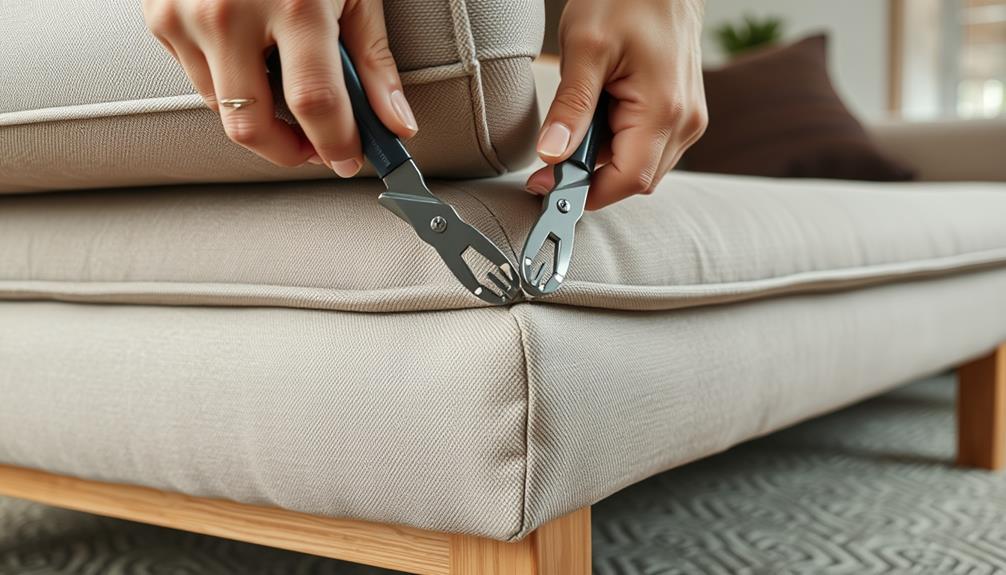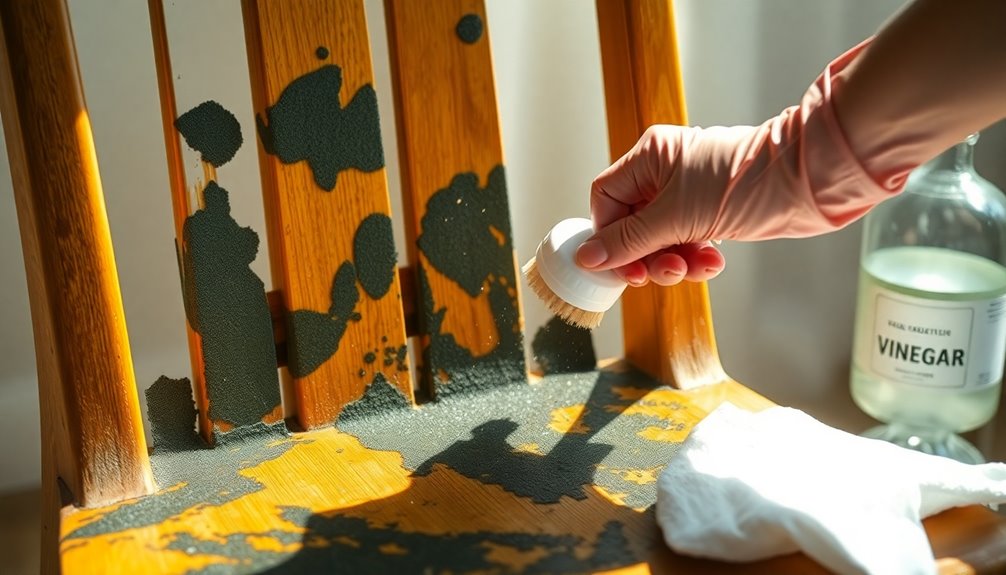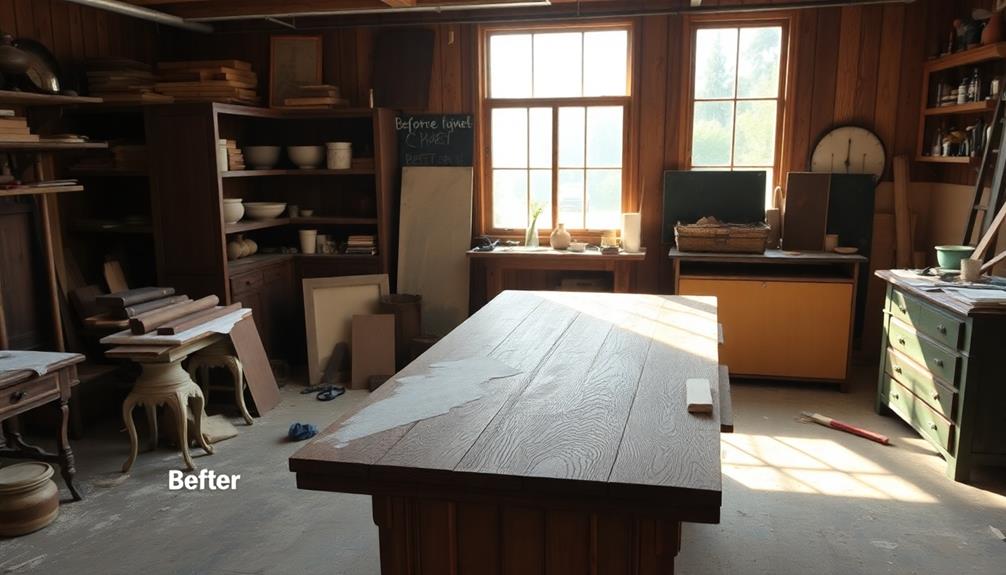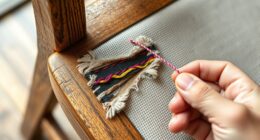To disconnect a sectional sofa with pins, you should begin by taking off all the cushions for better access. Check the ends and center of each piece for locking pins, which usually have a keyhole shape. Use pliers or vice grips to turn the pins counterclockwise, releasing them from the locking mechanism. Keep an eye out for any hidden pins or latches that could make the process more complicated. Make sure to keep the removed pins in a labeled sandwich bag so you don’t lose them. By following these steps, you’ll be able to disassemble the sofa smoothly, and you might even learn some useful tips for putting it back together.
Key Takeaways
- Remove all cushions and pillows to access the connection points easily.
- Locate locking pins on the ends and center of each sectional piece.
- Use pliers or vice grips to turn pins counterclockwise and disengage them.
- Check for hidden pins or latches under the fabric or frame before disassembly.
- Store removed pins in a labeled sandwich bag for future reassembly.
Understanding Sectional Sofa Components
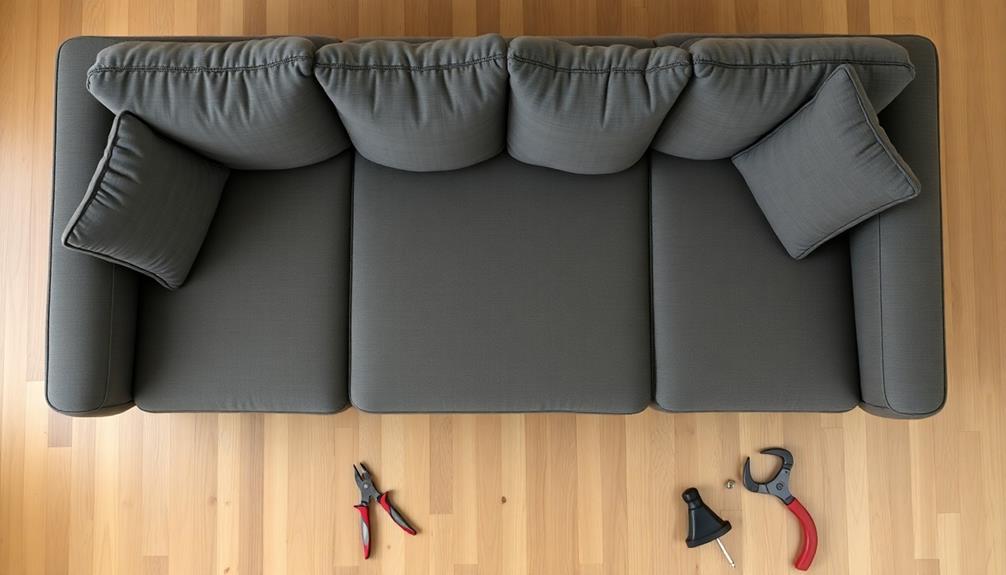
When you're looking to disconnect a sectional sofa, it's important to understand its components. Sectional sofas are made up of multiple pieces, and they often connect through various methods, with pin connectors being one of the most common. These pins usually feature a keyhole design, which simplifies disassembly when aligned correctly.
Many modern sectionals are designed with user-friendly features that enhance ease of use, similar to the best vacuum models designed for quick cleanups.
To start, inspect both the ends and the center of each sectional piece for these pins. Each model may have different locations for them, so thorough examination is essential.
Don't forget that some sectionals may include additional hidden pins or latches, which can complicate the disassembly process if overlooked.
Understanding how your sectional's pin connectors work is vital. Different manufacturers may use unique attachment methods, so familiarize yourself with your specific model.
This knowledge will help you disconnect the sections effectively, preventing any damage to the furniture. By being aware of how the pins function and where they're located, you can make the disassembly process smooth and straightforward, ensuring you can easily rearrange or move your sectional sofa as needed.
Tools and Preparation Steps
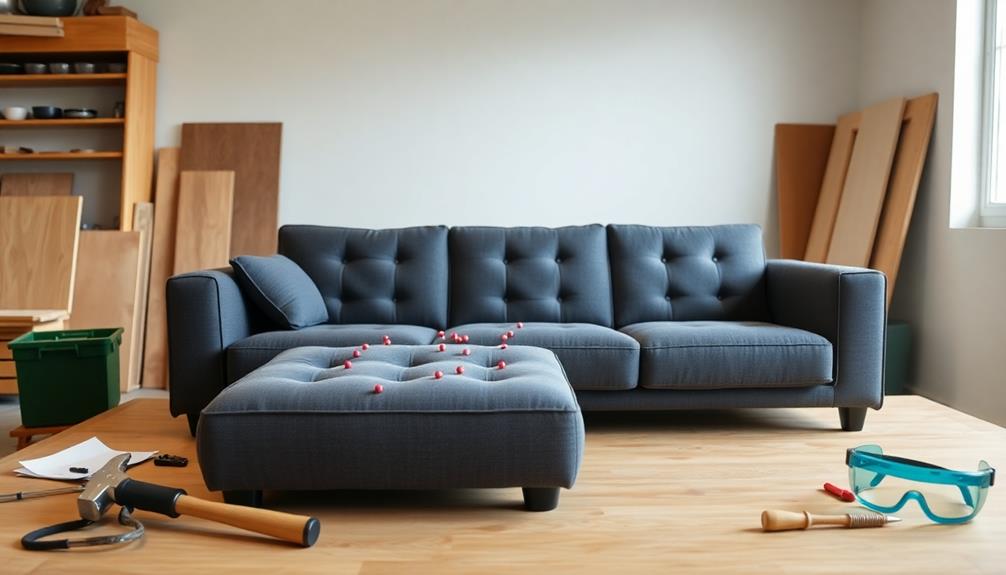
Before you start disconnecting your sectional sofa, gather the essential tools and prepare your workspace. You'll need pliers or vice grips to handle the locking pins, and it's a good idea to have a sandwich bag ready to safely store disassembled pins.
Additionally, consider your approach to organizing the tools and materials, as mastering the art of bug out bags can inspire effective packing strategies.
Next, clear the area around the sectional sofa to provide ample space for movement and guarantee a safe environment while you work. Removing all cushions and pillows is vital; this not only prevents obstruction but also gives you easy access to the pins and connection points.
Before diving in, inspect the underside of the sectional for hidden locking pins. Familiarizing yourself with their location can save you time and frustration during the disassembly process.
Lastly, consider enlisting the help of a second person. Having an extra set of hands will make lifting and managing the sectional pieces easier, reducing the risk of damage to both the sofa and your living space.
With the right tools and a well-prepared workspace, you'll be ready to tackle the disassembly efficiently.
Step-by-Step Disassembly Guide
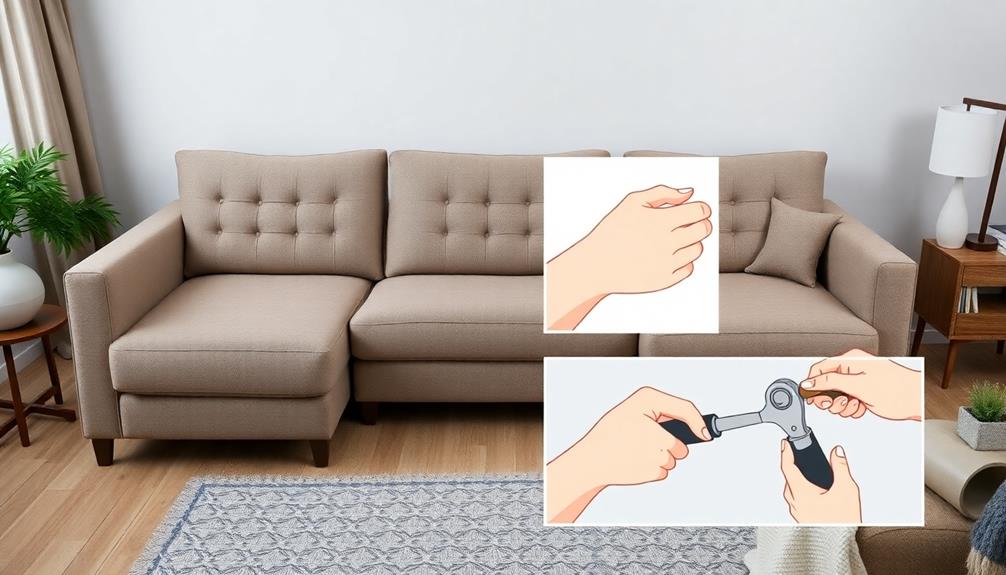
With your tools gathered and the workspace cleared, you're ready to tackle the disassembly of your sectional sofa. Follow these steps to disconnect each piece efficiently: Regular maintenance of your furniture can extend its lifespan, similar to how appliance upkeep can prevent unexpected issues.
- Remove the Cushions: Start by taking off all cushions from the sectional. This gives you clear access to the connection points and prevents any obstruction during the disassembly.
- Locate the Pins: Look for the locking pins on the ends and possibly in the center of each sectional piece. You might need to lift the sections slightly to reveal them.
- Release the Pins: Use pliers or vice grips to grasp the pins. Turn them counterclockwise to disengage the locking mechanism. After pulling out the pins, gently lift and separate the connected sections.
Be sure to check for any additional hidden pins or latches that may also need to be disengaged.
Once you have everything apart, store the pins in a labeled sandwich bag. This keeps them organized and prevents loss for future reassembly.
Common Challenges Faced
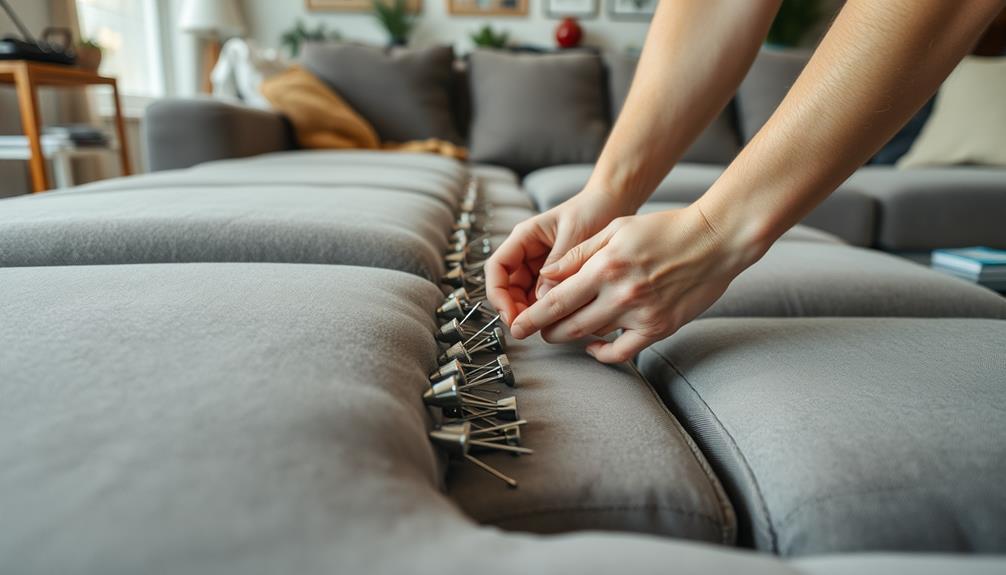
Disassembling a sectional sofa can present several challenges that may catch you off guard. First, locating all attachment points for pin connections can be tricky. Some pins might be hidden or obscured under the couch fabric or frame, making it tough to find all the necessary spots.
Additionally, heavy sections of the sectional can require extra strength or assistance. It's often difficult for one person to safely detach multiple pieces on their own. Misalignment of pins with keyholes can also complicate the removal process, leading to frustration if adjustments aren't made correctly.
Here's a quick overview of common challenges you may face:
| Challenge | Description | Solution |
|---|---|---|
| Hidden Pins | Pins obscured under fabric or frame | Inspect carefully |
| Heavy Sections | Difficulty moving large parts | Get help from a friend |
| Misaligned Pins | Pins not fitting into keyholes | Adjust carefully |
| Unique Attachment Mechanisms | Different models may have unique designs | Research your model |
| Overlooked Connections | Missing hidden pins or latches | Double-check all sections |
These obstacles can make the disassembly process more complex, so be prepared!
Tips for Successful Disassembly
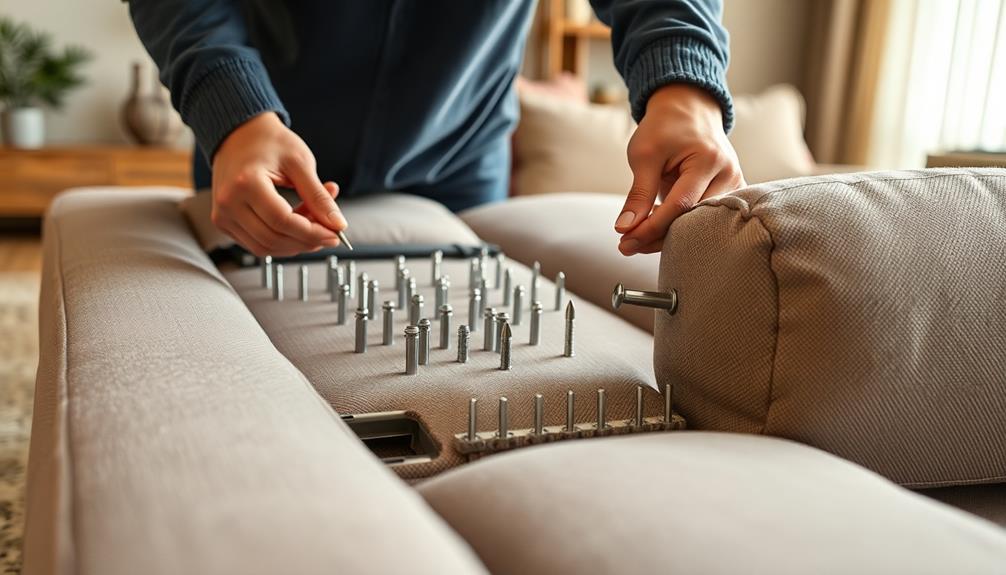
To kick off the disassembly process, make sure the area around your sectional is clear for easy movement and access to all connection points. This will help you maneuver and lift the piece without any obstructions.
It's also important to maintain a clean environment to avoid dust accumulation, similar to how you'd air purifier maintenance dos and don'ts for peak performance.
Here are some tips for a successful disassembly:
- Inspect Thoroughly: Use a flashlight to check underneath the couch for hidden pins or latches securing the sections together. You'll want to find these before attempting to separate anything.
- Lift Carefully: Gently lift each section near the connection points to see if it detaches easily. If you encounter resistance, you may need to locate additional pins.
- Remove Pins Safely: When it's time to remove the pins, grasp them with pliers or vice grips and turn counterclockwise to unfasten them. Be sure to place them in a sandwich bag for safekeeping.
Additionally, document your disassembly process with photos or notes. This will simplify reassembly later and keep track of which sections connect to one another.
Following these tips will make your disassembly process more efficient and organized.
Reconnecting Your Sectional Sofa

When reconnecting your sectional sofa, start by aligning the sections properly to guarantee the backs are straight.
It's also helpful to check that you have the right tools handy for any adjustments necessary.
You'll need to make certain the connectors engage securely, so pay attention to the clips and pins.
For peak performance, consider referring to tips on best home furniture assembly practices.
If you run into any alignment issues, don't hesitate to adjust before pushing the pieces together.
Proper Alignment Techniques
Proper alignment is vital for reconnecting your sectional sofa, as it guarantees a secure fit between the pieces. You want to make certain everything lines up perfectly, turning your sofa into one piece without any gaps. Follow these steps to achieve proper alignment:
1. Align the backs: Begin by verifying the backs of each sectional piece are properly aligned. This is essential for the locking pins to fit into their respective keyholes.
Additionally, much like understanding the mechanics of French press coffee, knowing how each part of your sectional fits together enhances the overall experience.
2. Check self-ratcheting clips: If your sectional uses self-ratcheting clips, confirm they're correctly positioned over the triangular posts on each section. Spin the clips as necessary to make certain they align smoothly.
3. Push together gradually: Gradually push the sectional pieces together, listening for the audible click that indicates a successful connection. If you don't hear a click, double-check the alignment before applying more force. Make sure that all the hooks and brackets are properly aligned, as forcing the pieces without proper alignment could damage the connectors or fabric. If you’re unsure about how to assemble sectional sofa pieces correctly, refer to the manufacturer’s instruction manual for specific guidance. Taking your time during this step will ensure a secure and long-lasting connection.
After reconnecting, gently tug on the sections to confirm they're securely fastened. Proper alignment not only enhances the appearance of your sectional but also guarantees it functions as one cohesive piece.
Ensuring Secure Connections
Securing connections is essential for a stable and functional sectional sofa. When reconnecting, take your time to align the backs of the sections properly. This guarantees that the connection points are matched for a secure fit. If your sectional uses pin connectors, make sure the pins are fully inserted into the keyholes before pushing the sections together. You should hear a clicking sound as the pieces connect, signaling that the locking mechanism has engaged correctly.
Here's a quick reference table to help you remember the key steps:
| Step | Action |
|---|---|
| 1. Align | Confirm backs of sections are matched |
| 2. Check Pins | Verify pins are fully inserted |
| 3. Listen for Click | Guarantee the locking mechanism engages |
| 4. Adjust Clips | Line up self-ratcheting clips and posts |
| 5. Tug to Test | Gently tug on sections to check security |
After you've reconnected everything, gently tug on each section to confirm they're securely attached before using your sectional. By following these steps, you'll enjoy a stable and cozy seating arrangement.
Troubleshooting Connection Issues
Even with secure connections, you might run into issues while reconnecting your sectional sofa. To guarantee a smooth process, make sure to follow these steps: Remember that preparation is key, much like how effective preparation maximizes consultation outcomes in interior design basics.
- Align the Clips: When reconnecting, verify that the self-ratcheting clips align properly with the triangular posts. This alignment is vital for a secure connection.
- Check for Misalignment: If you notice any misalignment, gently spin the clips until they're correctly positioned. This step is important before pushing the pieces together.
- Listen for the Click: As you push the sections together, listen for that distinct clicking sound. This sound indicates that the sections have locked into place securely.
If the sections don't connect easily, check for any obstructions or debris in the connection points. Removing these can help facilitate a proper fit.
After reconnecting, always double-check the stability by gently pulling on the sections to verify they're secure. Following these troubleshooting tips will help you enjoy your sectional sofa without any connection issues.
Maintenance and Care Tips
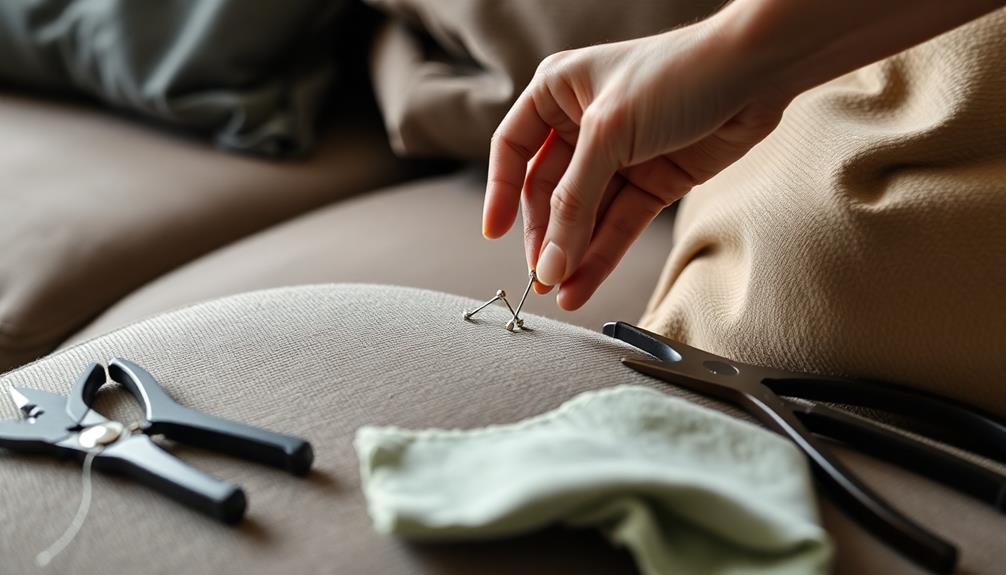
To keep your sectional sofa looking great and functioning well, regular maintenance is vital. Here are some simple maintenance and care tips you can follow to guarantee your sofa remains in top shape:
| Task | Frequency |
|---|---|
| Inspect pins and connectors | Monthly |
| Vacuum fabric surfaces | Weekly |
| Rotate and flip cushions | Every 3 months |
| Clear area around sofa | As needed |
| Check and tighten loose parts | Monthly |
Start by inspecting the pins and connectors monthly for any signs of wear or damage, guaranteeing a secure connection. Vacuum the fabric surfaces weekly to maintain their appearance and extend their life. Rotating and flipping cushions every three months will promote even wear and prevent sagging. Keep the area around your sectional free of heavy objects to avoid unnecessary strain on the connectors and frame. Finally, check and tighten any loose parts or screws monthly to maintain stability and prevent potential damage during use. Following these maintenance and care tips will help your sectional sofa stay comfortable and safe for years to come.
Additional Resources and Assistance
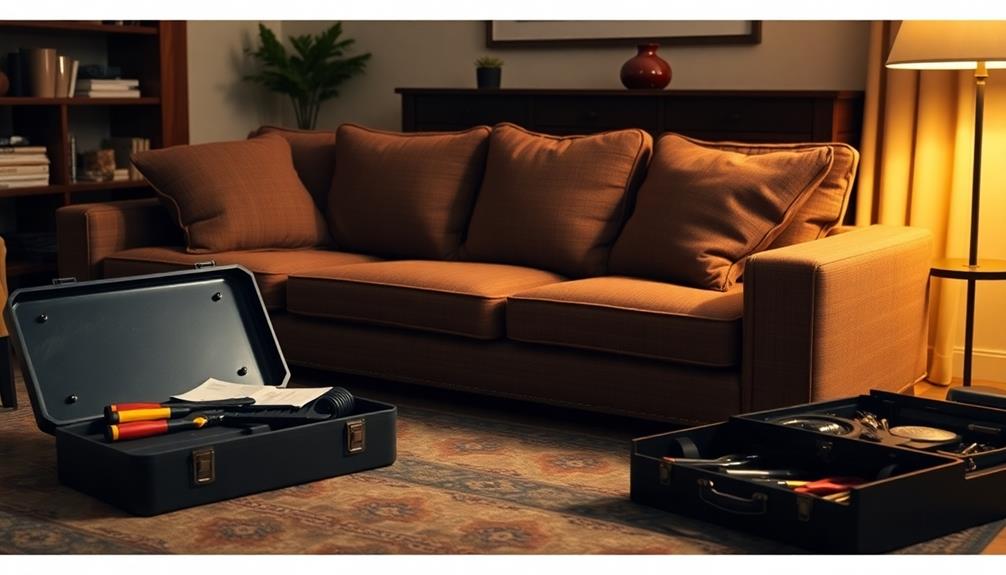
If you need a little extra help disconnecting your sectional sofa, video tutorials on platforms like YouTube can be lifesavers. These guides walk you through the process step-by-step, making it easier to tackle any model.
You might also explore the role of color accuracy in home cinema projectors to enhance your viewing experience. Additionally, don't hesitate to reach out to local furniture stores for expert tips on arrangement and disassembly.
Video Tutorials Available Online
Mastering the art of disconnecting a sectional sofa can be made simpler with the wealth of video tutorials available online. Platforms like YouTube are treasure troves of step-by-step demonstrations that guide you through the disassembly process.
These tutorials often cater to various sectional sofa models, showcasing techniques tailored to your specific design. Additionally, understanding the importance of selecting the right cold medication can parallel the need for the right approach when tackling furniture assembly or disassembly.
Here are three key benefits of using these video resources:
- Visual Learning: You'll get to see real-life examples that clarify the location of hidden pins and connectors, making the process easier to understand.
- Safety Tips: Many videos emphasize the importance of using proper tools, like pliers, to efficiently remove locking pins without damaging your sectional sofa.
- Troubleshooting Guidance: Engaging with these tutorials can provide you with handy troubleshooting tips, enhancing your furniture disassembly skills.
Expert Furniture Arrangement Tips
Having learned how to disconnect your sectional sofa through online tutorials, you're now equipped to move on to arranging it effectively in your space. Start by considering the flow of the room. Make certain each piece of the sectional is easily accessible to encourage conversation and movement.
For added peace of mind, consider the value of home security systems in your area, which can greatly enhance your overall living experience increased safety and peace of mind. Use a tape measure to confirm that the sectional fits well, leaving enough space for other furniture and pathways.
Don't hesitate to experiment with different configurations. Temporarily place the sectional in various positions to discover the most comfortable and visually appealing layout.
Keep the proportions of your sectional in mind; larger sections can dominate smaller rooms, so balance them with smaller accent pieces or furniture to maintain harmony.
Also, think about the orientation of your sectional. Position it in relation to focal points like a fireplace or television, making sure that seating arrangements promote engagement with these features.
Frequently Asked Questions
Can You Detach Sectional Sofa?
Yes, you can definitely detach a sectional sofa. Just locate the connecting pins, lift the sections slightly, and pull or twist the pins out. Don't forget to check for any hidden connections that might be present.
Can I Separate a Sectional Sofa?
Yes, you can separate a sectional sofa easily. Just check for hidden connectors, lift the sections gently, and pull them apart. Having someone assist you can make the process smoother and safer.
How Do I Disconnect a Corner Sofa?
Disconnecting a corner sofa might feel like performing an acrobatic feat! Start by removing the cushions, find those sneaky pins underneath, lift gently, and voilà—your sofa's ready for a new arrangement! Don't forget to keep the pins safe! Once the sections are detached, carefully rotate each piece to ensure it comes apart smoothly without damaging any fabric or frame. If you’re still unsure about the process, a quick search on how to disassemble a sofa can provide additional tips and tricks specific to your model. Finally, remember to group all small pieces, like pins or screws, in a labeled bag to avoid losing them during reassembly!
How Do Sectional Connectors Work?
Sectional connectors typically use metal pins that fit into keyhole openings, allowing you to easily attach or detach sections. You'll need to lift and align each piece for seamless connection or disconnection.
Conclusion
You might think disconnecting your sectional sofa is an intimidating task, but it's easier than you think! With the right tools and a little patience, you can tackle it like a pro. Remember, those pins holding your sofa together are just a few twists away from giving you the flexibility you need. So, don't hesitate to jump in—your living space will thank you for it! Plus, you might discover a hidden treasure beneath those cushions!
